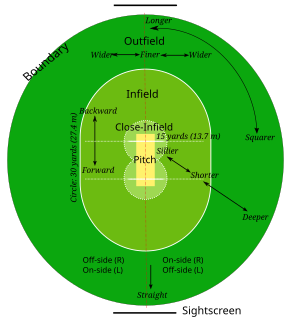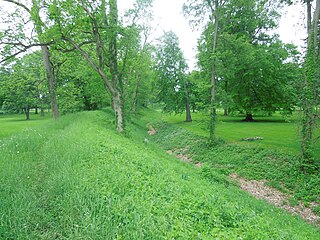Related Research Articles

Area is the quantity that expresses the extent of a two-dimensional region, shape, or planar lamina, in the plane. Surface area is its analog on the two-dimensional surface of a three-dimensional object. Area can be understood as the amount of material with a given thickness that would be necessary to fashion a model of the shape, or the amount of paint necessary to cover the surface with a single coat. It is the two-dimensional analog of the length of a curve or the volume of a solid.

The acre is a unit of land area used in the imperial and US customary systems. It is traditionally defined as the area of one chain by one furlong, which is exactly equal to 10 square chains, 1⁄640 of a square mile, or 43,560 square feet, and approximately 4,047 m2, or about 40% of a hectare. Based upon the International yard and pound agreement of 1959, an acre may be declared as exactly 4,046.8564224 square metres. The acre was sometimes abbreviated ac, but was often spelled out as the word "acre".

A furlong is a measure of distance in imperial units and U.S. customary units equal to one eighth of a mile, equivalent to 660 feet, 220 yards, 40 rods, 10 chains or approximately 201 metres. In the United States some states use older definitions for surveying purposes, leading to variations in the length of the furlong of two parts per million, or about 0.4 millimetre. This variation is too small to have practical consequences in most applications.

The yard is an English unit of length, in both the British imperial and US customary systems of measurement, that comprises 3 feet or 36 inches. Since 1959 it is by international agreement standardized as exactly 0.9144 meters. 1,760 yards is equal to 1 mile.

The square metre or square meter is the SI derived unit of area with symbol m2.
The foot (pl. feet), standard symbol: ft, is a unit of length in the British imperial and United States customary systems of measurement. The prime symbol, ′, is a customarily used alternative symbol. Since the International Yard and Pound Agreement of 1959, one foot is defined as 0.3048 meters exactly. In customary and imperial units, one foot comprises 12 inches and one yard comprises three feet.
The rod or perch or pole is a surveyor's tool and unit of length of various historical definitions, often between 3 and 8 meters. In modern US customary units it is defined as 16+1⁄2 US survey feet, equal to exactly 1⁄320 of a surveyor's mile, or a quarter of a surveyor's chain, and is approximately 5.0292 meters. The rod is useful as a unit of length because whole number multiples of it can form one acre of square measure. The 'perfect acre' is a rectangular area of 43,560 square feet, bounded by sides 660 feet long and 66 feet wide or, equivalently, 40 rods and 4 rods. An acre is therefore 160 square rods or 10 square chains.

The square foot is an imperial unit and U.S. customary unit of area, used mainly in the United States and partially in Canada, the United Kingdom, Bangladesh, India, Nepal, Pakistan, Ghana, Liberia, Malaysia, Myanmar, Singapore and Hong Kong. It is defined as the area of a square with sides of 1 foot.
The chain is a unit of length equal to 66 feet. It is subdivided into 100 links or 4 rods. There are 10 chains in a furlong, and 80 chains in one statute mile. In metric terms, it is 20.1168 m long. By extension, chainage is the distance along a curved or straight survey line from a fixed commencing point, as given by an odometer.

Riverside South is an urban development project in the Lincoln Square neighborhood of the Upper West Side of Manhattan, New York City. It was originated by six civic associations – The Municipal Art Society, Natural Resources Defense Council, New Yorkers for Parks, Regional Plan Association, Riverside Park Fund, and Westpride – in partnership with real estate developer Donald Trump. The largely residential complex, located on the site of a former New York Central Railroad yard, includes Trump Place and Riverside Center. The $3 billion project is on 57 acres (23 ha) of land along the Hudson River between 59th Street and 72nd Street.
English units are the units of measurement used in England up to 1826, which evolved as a combination of the Anglo-Saxon and Roman systems of units. Various standards have applied to English units at different times, in different places, and for different applications.
The bigha is a traditional unit of measurement of area of a land, commonly used in India, Bangladesh and Nepal. There is no "standard" size of bigha. The size of a bigha varies considerably from place to place. The size of Bigha is different in different areas.
Plethron is an ancient unit of Greek measurement equal to 97-100 Greek feet, although the measures for plethra may have varied from polis to polis. This was roughly the width of a typical ancient Greek athletic running-track.

A cricket field is a large grass field on which the game of cricket is played. Although generally oval in shape, there is a wide variety within this: some are almost perfect circles, some elongated ovals and some entirely irregular shapes with little or no symmetry – but they will have entirely curved boundaries, almost without exception. There are no fixed dimensions for the field but its diameter usually varies between 450 feet (137 m) and 500 feet (150 m). Cricket is unusual among major sports in that there is no official rule for a fixed-shape ground for professional games. On most grounds, a rope demarcates the perimeter of the field and is known as the boundary.

In poultry keeping, yarding is the practice of providing the poultry with a fenced yard in addition to a poultry house. Movable yarding is a form of managed intensive grazing.

The Newark Earthworks in Newark and Heath, Ohio, consist of three sections of preserved earthworks: the Great Circle Earthworks, the Octagon Earthworks, and the Wright Earthworks. This complex, built by the Hopewell culture between 100 BCE and 400 CE, contains the largest earthen enclosures in the world, and was about 3,000 acres in total extent. Less than 10 percent of the total site has been preserved since European-American settlement; this area contains a total of 206 acres (83 ha). Newark's Octagon and Great Circle Earthworks are managed by the Ohio History Connection. A designated National Historic Landmark, in 2006 the Newark Earthworks was also designated as the "official prehistoric monument of the State of Ohio."

An animal pound is a place where stray livestock were impounded. Animals were kept in a dedicated enclosure, until claimed by their owners, or sold to cover the costs of impounding.
The following are the basic measurements of land used in the Punjab region, divided between Indian and Pakistani Punjab and Haryana in ascending order.
The History of measurement systems in Pakistan begins in early Indus Valley Civilization when pastoral societies used barter to exchange goods or services and needed units of measurement.
References
- ↑ Holland, Robert, A glossary of words used in the County of Chester, 1886, p. 3.